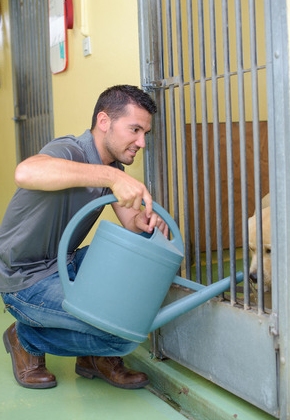Burnout
Why Do Animal Shelter Workers Burn Out?
New research reveals some downsides to "being called" to save animals.
Posted May 4, 2017

I have interviewed many people whose work with animals is a calling that begins in childhood. Sometimes their love for animals translated into fulfilling careers, and they became veterinarians, professional animal advocates, and even circus animal trainers. But, for others, things did not turn out so well. Take, for example, two animal shelter workers I will call Becky and Fran.
Becky was the director of a municipal animal shelter in a mid-sized city. When I interviewed her, she had been working in shelters for 15 years. Her shelter took in about eight thousand dogs and cats a year, 40% of which would have “good endings.” That’s shelter-speak for being adopted into a new home. The rest of the animals, including most of the cats and nearly all the pit-bull mixes, would be taken one day into a small room and injected with sodium pentobarbital. Becky tells me the animals slip away within seconds.
Becky is cheerful. She loves her job, and she loves animals. But the paradox of her profession became apparent when I asked her how many dogs and cats she had personally euthanized over the years.
She looked at me like I was an idiot.
“Over a thousand?” I asked meekly.
After a pause, she said, “At least.”
“How do you stay sane?” I asked.
“Somebody has to do it,” she said. “I don’t obsess about it.”
But not all shelter workers are upbeat about their profession. Becky shows me an e-mail she had just gotten from Fran, a bitter and angry shelter worker who goes home every night and cries. The message said “I hate my job. I hate that it exists… I do my best to save every life, but there are more animals coming in every day than there are homes.” Becky tells me Fran is in the wrong line of work.
Being “Called” To Help Animals
Both women were deeply committed to the welfare of animals. But why did Becky flourish in an emotionally challenging occupation in which dogs and cats are routinely put to death while Fran became an emotional wreck?
Kira Schabram of the the University of Washington and Sally Maitlis of the University of Oxford have investigated the challenges faced by animal shelter workers. Their results were recently published in the Academy of Management Journal. Dr. Schabram, the lead author, was particularly well-suited for the project. She told me she has felt called to improve the lives of animals since she was a child. As a teenager, she started volunteering at her local animal shelter, and she spent several years as a full-time shelter worker. In 2015 she was named the Volunteer of the Year by the British Columbia Society for the Prevention of Cruelty to Animals.
Dr. Schabram interviewed 50 former and current shelter workers from across the United States. As is typically the case with people involved in animal welfare-related professions, most of the participants were women (86%). Their average age was 35, and they had worked in shelters an average of five and a half years. Like other people who are “called” to a career, all the shelter workers in the study entered the field with a sense of deep moral, social, and personal commitment. But caring for animals can have its costs. Two thirds of the shelter workers in the study burned out and eventually left the profession for other careers. The researchers discovered that the seeds of their disillusionment with saving animals in shelters was usually apparent from the beginning.

Three Diverging Paths
Animal shelter work is, in the parlance of sociology, “dirty work.” Not only is it physically dirty and low paid, shelter workers are often disparagingly thought of as “animal rights nuts” on the one hand and “dog catchers” on the other. All of the participants in the study, however, entered the field with a deep love for animals and a desire to make the lives of dogs and cats better. There were other commonalities among the participants as well. For example, all of them experienced bouts of negative emotions such as anger and depression which were followed by attempts to get a new more positive perspective on their jobs.
But Schabram and Maitlis reported that the professional lives of the shelter workers eventually diverged into three different “calling pathways.” And only one of these proved successful over the long haul.
Unsuccessful Calling Path #1: “Identity-Oriented”
The 22 individuals on this career tract believed they had a special gift when it came to working with animals, (“I just had a love of animals, always wanted to be with them.”) But early on, their idealism began to clash with the harsh reality of shelter work, and particularly the euthanasia of unwanted dogs and cats. Soon they began to ask “why the hell am I here.” Their tempers would flare, and they distanced themselves with their coworkers. They often became intensely angry and had frequent conflicts with their bosses. The researchers wrote, “Workers on the identity path came to see shelter work as fundamentally painful and constrained and (they saw) themselves as being uniquely capable of carrying the burden…” But at some point the burden became too heavy. Many of them became depressed, anxious, and physically ill. As one said, “”Working in an animal shelter full time, I realized it, like, destroys you as a human being. “
While they were still dedicated to animals, eventually the identity career-oriented workers came to consider shelters toxic environments in which they could no longer work. Yet animals remained central to their lives, and at the time they were interviewed, 17 of them had shifted from animal shelter work to into other animal-related professions. These included pet grooming, veterinary care, dog training, and pet photography.
Unsuccessful Calling Path #2: “Contribution-Oriented”
Eighteen of the shelter workers were on the contribution-orient career trajectory. The workers on the contribution path also believed they had a unique gift for relating to animals. They initially felt less anger than those on the identity-oriented path when they had to confront the reality of their new jobs, but they became increasingly disenchanted when they could not meet their career and animal protection goals. And, unlike those on the identity path, these shelter workers sought to make a difference to animals by seeking management positions in their shelters. But moving up the professional ladder created new sets of frustrations for them. At the time of the interviews, two-thirds of the individuals in this group had changed professions when their disenchantment with shelter bureaucracy and institutional politics became unbearable. However, they tended to seek new jobs in non-animal related professions.
The Successful Calling Path: “Practice-Oriented”
Only one of the three career paths led to occupational satisfaction for all the participants. All 10 shelter workers on the practice-oriented trajectory were in the profession at the time they were interviewed. Like the two paths which lead to burnout, shelter workers in the practice-oriented career pathway were also passionate in their desire to help animals. But unlike shelter workers on the unsuccessful paths, these participants did not initially consider themselves to be particularly gifted or skilled when it came to relating to animals. The researchers argue that their more modest expectations made them better equipped to deal with the emotional challenges of shelter work. They seem to experience less of the dissonance that comes from being an animal lover in a job where “bad endings” usually outnumber “good endings.”
As new hires, they approached their jobs as opportunities to learn and acquire skills. Over time their confidence developed, and they, came to view themselves as skilled practitioners. While they were not immune from the stresses of their occupation, they were better at coping with issues that led to disillusionment among workers on the other paths. One, for example, said “I feel really strong emotions in terms of sadness and discouragement sometimes….but that generally leads me to a place of, you know, being motivated to change the problem.” Unlike the burned out shelter workers, their experiences made them feel fatigued, yet empowered and happy.
This group remained committed, they kept true to their calling. This was exemplified by a woman who told Kira, “I can’t imagine life without the SPCA, it’s so ingrained in everything I do. Leaving would be worse than a divorce. I think I would grieve it like a loss."
The Animal Shelter Workers' Paradox
I took away two messages from this important research.
First, there was no middle ground among people who felt “called” to work in animal shelters. As the researchers wrote, “They either followed a practice path that produced learning and growth, or one of two other paths that generated intense negative emotions and culminated in burnout and exit from the profession."
The second is “the shelter worker’s paradox.” It is that individuals who felt called to shelter work because they believed they had a special gift with animals were most likely to ultimately crash, burn, and ultimately bail out of the profession. Could this is also true of other “calling professions” like teaching, social work, and veterinary medicine?
And, by the way, if you are looking for a job, the Department of Labor Statistics estimates that an additional 25,000 animal care and service workers will be needed over the next decade. But they add, “Some of the work may be physically or emotionally demanding, and the rate of work-related injuries and illnesses is higher than the national average.”
For more on compassion fatigue among animal shelter workers see this excellent article from the Sacramento Bee, and in this Psych Today post Marc Bekoff discusses emotional burnout in animal rescuers.
* * * *
Hal Herzog is Professor Emeritus of Psychology at Western Carolina University and the author of Some We Love, Some We Hate, Some We Eat: Why It’s So Hard To Think Straight About Animals.
Follow on Twitter.
References
Schabram, K., & Maitlis, S. (2017). Negotiating the challenges of a calling: Emotion and enacted sensemaking in animal shelter work. Academy of Management Journal, 60(2), 584-609.




